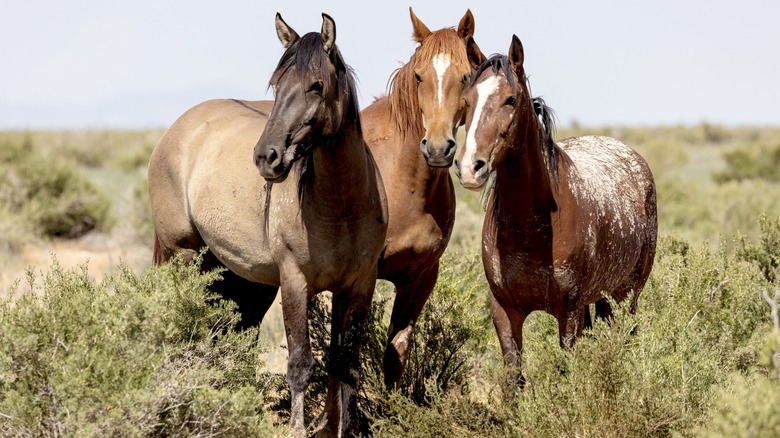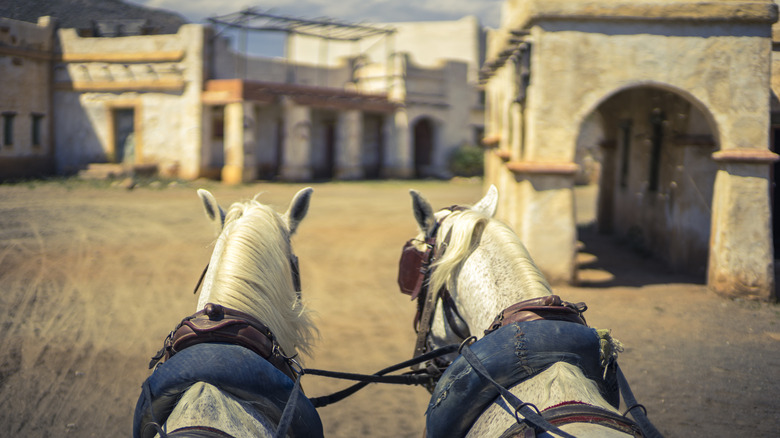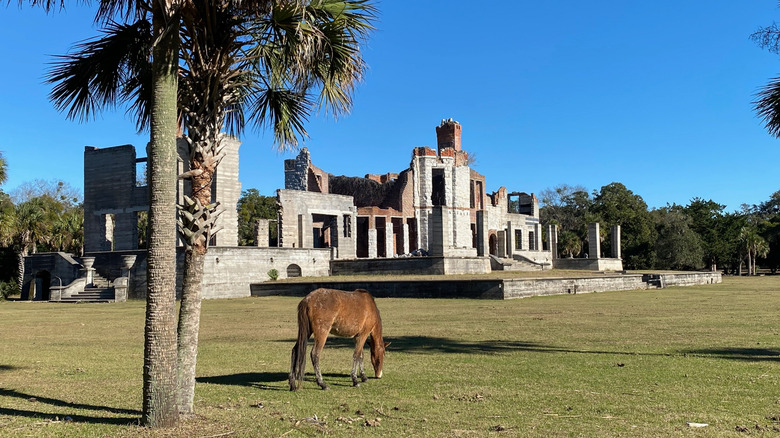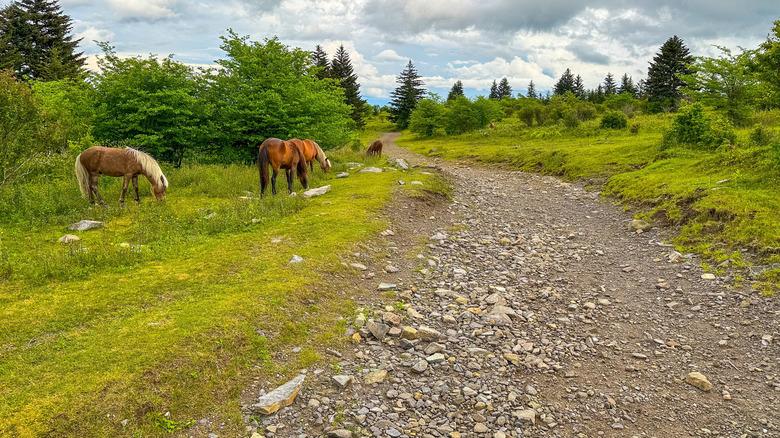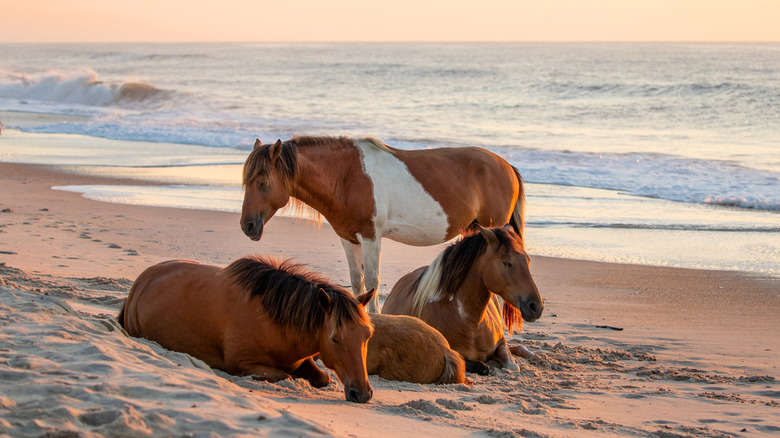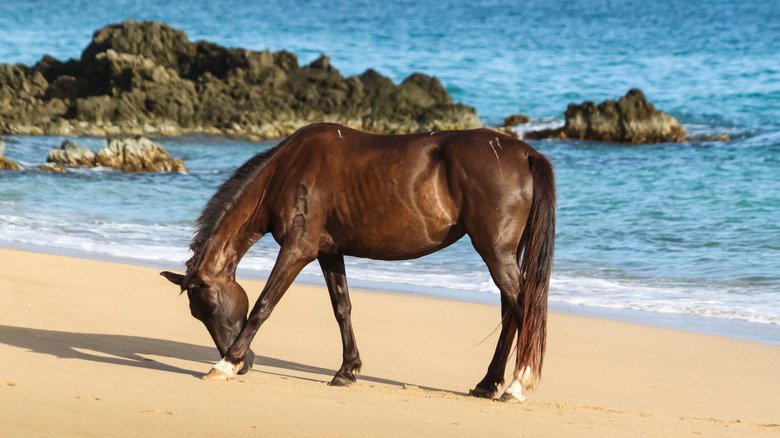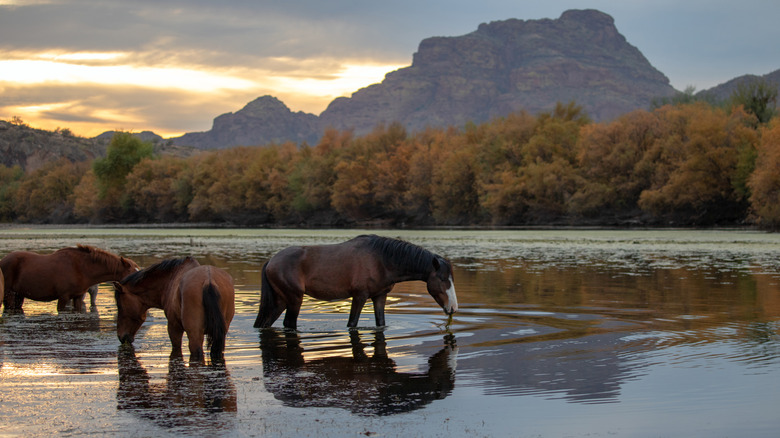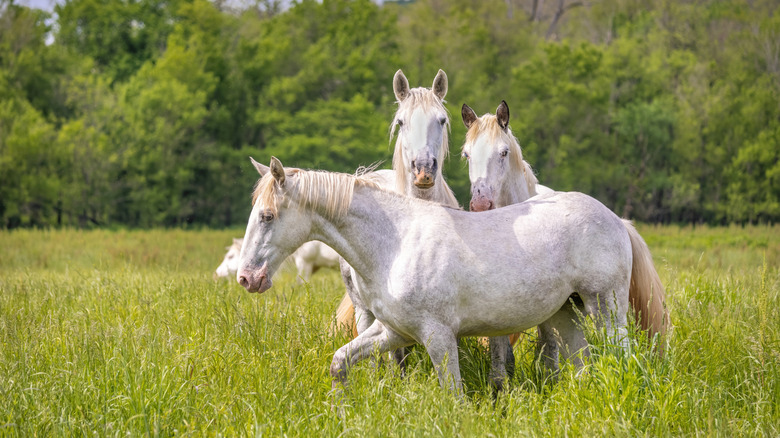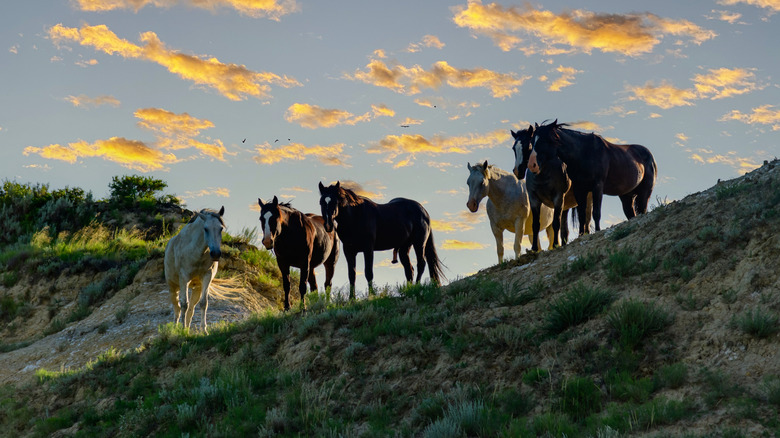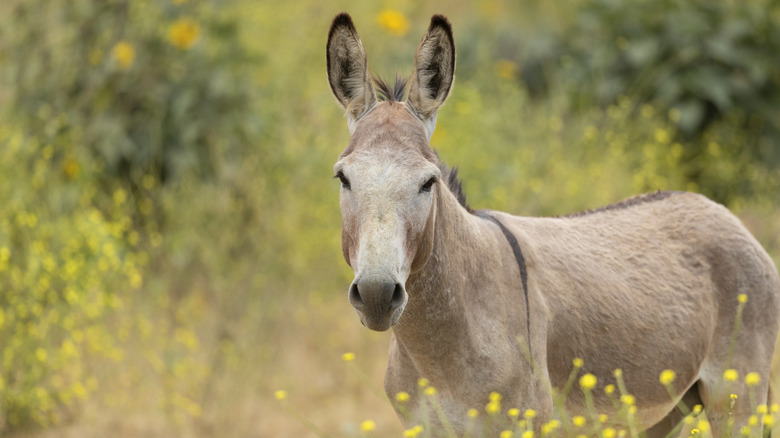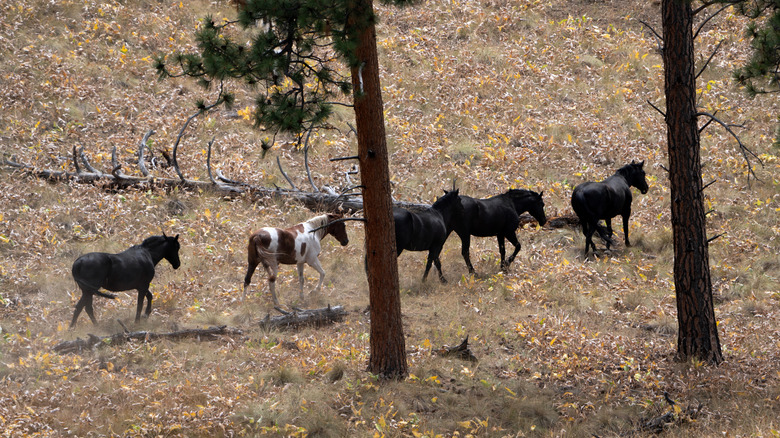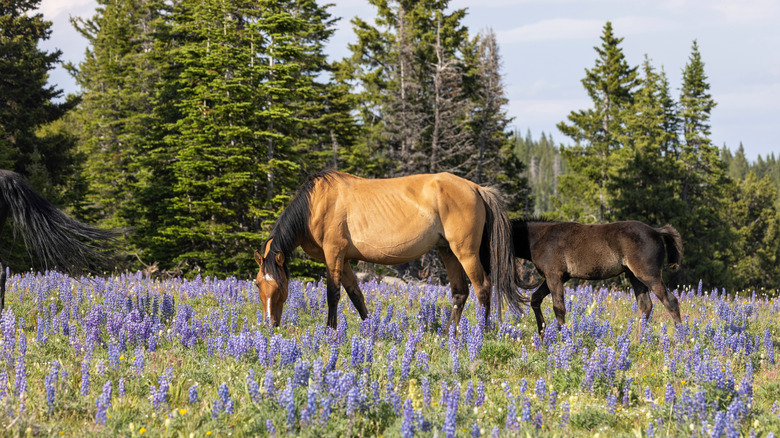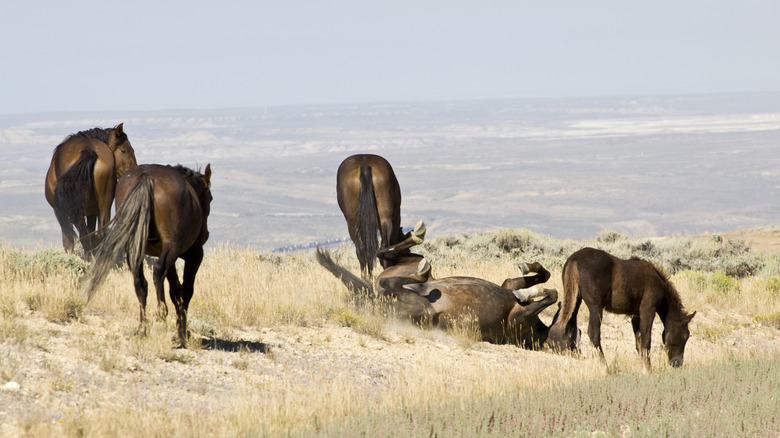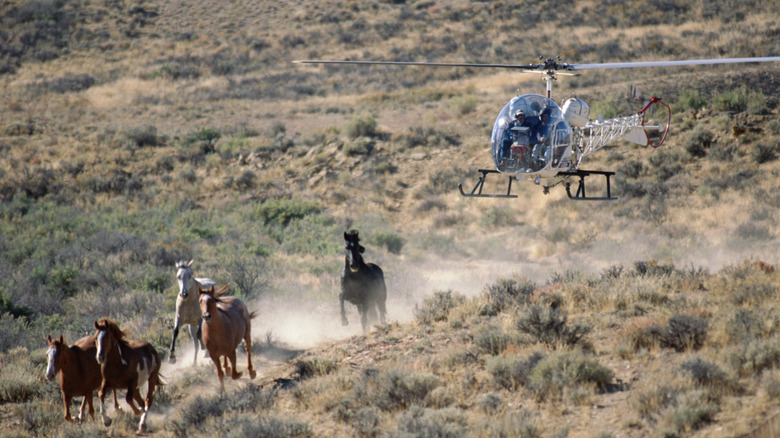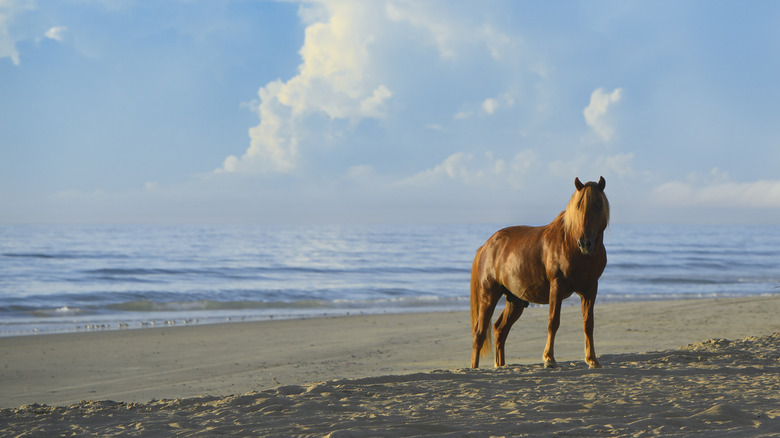Wild Horses Roam Freely At These 13 Unforgettable U.S. Destinations
The mythic creatures that represent the spirit of American freedom still roam in several parts of the U.S. While you can't get too close (these are big, wild animals after all), there are many sites open to equine-inclined travelers who want to catch a glimpse of their magic. In fact, across the west, there are at least 175 federally-recognized areas where horses roam freely.
Horses have wandered their way through American history and culture and onto the sandy shores of remote islands and across rugged terrains. "You may be surprised to learn that wild horses naturally thrive in relatively severe conditions, despite how pampered some domestic horses are," wild horse photographer Deb Lee Carson shared on her website. "Wild horses tend to do best in environments with plenty of wide-open space like arid plains, grasslands, prairies, high deserts, and mountainous regions."
Before rounding up all the destinations, let's pause for a moment to appreciate the long, remarkable journey of the wild horse. How exactly did so many end up in the U.S.? Hold on to your britches: We're covering thousands of years of history in just a blip.
What makes a horse wild?
As a species, horses are thought to have originally evolved in the Americas. However, archeological evidence suggests that they went extinct there about 10,000 years ago. By then, however, many populations had already traveled and spread to other far away corners of the globe. This included Europe and Asia, where they began to evolve alongside humans and become domesticated. In the 15th and 16th centuries, Europeans traveling to the Americas took their main mode of land transportation with them. The Spanish are especially credited with bringing horses to the region.
Over hundreds of years of colonization, horses took on many new and diverse functions across Indigenous, settler, and immigrant cultures. Some escaped, while others were set free or altogether forgotten. The so-called "wild" horses that roam across the U.S. today are actually descended from horses that were previously tamed, and for one reason or another, found a way to survive away from humans. As a result, whether you're a seasoned rider, a cowboy core trend-setter, or just horse curious, there's sure to be an open trail that suits your gait.
1. Outer Banks, North Carolina
Along a salty stretch of barrier island in North Carolina, you can find what are rumored to be some of the direct descendants of the original horses brought over by Spanish colonizers. The sea-side area is known as the Outer Banks. Several herds of horses (about 400 horses total) roam just north of the tourist-friendly town of Corolla. Another herd can be found on the southernmost island of the Outer Banks, Shackleford Banks.
The herds have survived in this ecosystem for almost 500 years. Their exact origins are a source of ongoing debate. The shallow waters surrounding the area house many historic shipwrecks, some of which may have been transporting horses from Europe to the Americas.
In the northern part, the areas where the horses roam are only accessible by four-wheel vehicles. So, you may want to book a tour to secure higher chances of viewing them. Of course, the location lends itself to many oceanside adventures. If you're interested in diving deeper into the shipwrecks, you can visit several through water adventures such as SUPing, kayaking, and snorkeling.
2. Cumberland Island, Georgia
Further down on the East Coast, you can find a unique herd of wild horses roaming the largest and southernmost of Georgia's Golden Isles, Cumberland Island. These feisty equines are the only herd in the region not managed by the park service or any other group of humans. They're often spotted grazing between sandy dunes, and amongst the haunting historic ruins left on the island, such as the Dungeness Mansion, a former home of the Carnegie family.
The 20-mile long island is a historically rich location that is a designated national park. It's accessible by a 45-minute ferry ride from the mainland town of St. Mary's, Georgia. There are no commercial businesses, so be sure to pack everything you need.
Visitors can camp on Cumberland Island, and go fishing, hunting, beach combing, and stargazing. Guided tours offer a great deal of historical context, and access to some sites that are otherwise difficult to reach, like the picturesque African First Baptist Church built after the Civil War for the community of formerly enslaved African Americans who lived there.
3. Mount Rogers, Virginia
If you're looking for a wild horse adventure at a higher elevation, try further inland on the highest peak in the state of Virginia: Mount Rogers. A herd of about 120 wild ponies has been living along a stunning portion of the Appalachian Trail since the 1940s. Grayson Highlands State Park and Mount Rogers National Recreation Area overlap to form an area of 200,000 acres for these majestic creatures to graze and climb.
Ponies and horses are members of the same species, but differ significantly in height. If it's under 57 inches tall, it's typically considered a pony. Every year, some of the Mount Rogers ponies are captured and auctioned off to keep the population in balance with the habitat's available resources at the Grayson Highlands Fall Festival in the small community of Mouth of Wilson, just southeast of the mountain. The festival showcases the best of Appalachian culture, including how horses and mules were once used in producing molasses and apple cider. Visitors can also see musical performances and browse many local artisanal vendors.
4. Assateague Island, Maryland & Virginia
If ponies are your thing, you won't want to miss the absolutely iconic Chincoteague ponies. Similar to their other siblings along the East Coast, their origin story is also believed to be linked to a fateful Spanish shipwreck. Assateague Island spans both Maryland and Virginia, and each state has its own distinct herd. Once numbering in the thousands, the total current population of horses on the island is around 150, and ecologists are working hard to restore it.
With their wind-swept manes and magical presence dotting the lush marshes along Assateague Island, it's no wonder one of these little guys inspired a children's book and film that captured the imagination of the nation. If you're familiar with Misty's story, there are several fan sites to check out in Chincoteague connected to her lore, including Misty's hoofprints preserved in cement in front of the town's theatre at the premier of the film back in 1961. Visitors can also find fun events at Chincoteague Pony Center, which has a museum and offers pony rides, shows, and lessons.
5. Vieques Island, Puerto Rico
Combine your love of horses with a tropical island excursion by visiting Vieques Island, which sits just 7 miles east of the island of Puerto Rico – a short ride by ferry or flight away. Over the last few years, Vieques has been dealing with a surge in its wild horse population. Thousands of horses roam freely there. You can't miss them. Though, since they are one of the main island attractions, they've become a bit less wild and quite adapted to human interaction.
The culture of the island is horse-inclusive, with many people using horses as their main mode of transportation, and regular gatherings among locals on horseback in spirited events called "cabalgatas." Several horseback riding businesses exist there that are oriented towards giving visitors unforgettable sunset rides on the beach. This destination is also well known for its radiant, bioluminescent bays that are considered some of the brightest in the world, according to the Guinness Book of World Records.
6. Salt River, Arizona
Just outside of Phoenix, within the Sonoran Desert region, wild horses can be found along the banks of the lower portion of Salt River. It's not hard to spot them whether you travel the area by car, foot, or boat, as there are nearly 300 of them. They`re frequently seen grazing on river eelgrass in the Tonto National Forest and the Salt River Pima-Maricopa Indian Reservation.
If you're up for a hike, there are several spots that locals say are common for wild horse sightings: the Blue Point, Goldfield, Coon Bluff, Phon D. Sutton, Water Users, and Granite Reef. If you're ready to paddle, you can try kayaking, tubing, or paddle boarding down the calm waters of the river. If all that paddling leaves you hungry for more, it's worth stopping by the Huhugam Ki: Museum where visitors can learn about the Indigenous cultures and their relationship to horses through archives and exhibits featuring traditional and contemporary artists. The Saguaro Lake Guest Ranch provides cozy, rustic accommodations nearby.
7. Steens Mountain, Oregon
In southeastern Oregon, Steens Mountain is home to herds of wild mustangs, including a distinct breed called the Kiger mustang, or Kiger mesteño. These horses are known for their close genetic ties to the original Spanish breeds. Their coats are often a sandy yellow-brown color known as "dun," and they may display primitive markings like zebra-striped legs or a dark stripe down the back.
The wild horses of Steens Mountain roam within a massive preserve of more than 400,000 acres of rugged beauty, filled with diverse deserts and meadows of wildflowers. Accessing the area the herds are known to traverse can be difficult, and requires traveling long distances on unpaved roads. Finding a local tour operator, some of which offer horseback riding excursions, may be a good option.
Detailed information about wild horses in the region can be found at the Oregon Wild Horse Corral in Burns. Several campgrounds are available around Steens Mountain, including Page Springs Campground, Fish Lake Campground, and South Steens Campground. There are also many activities in the area, such as alpine hiking, camping, hunting, fishing, and more.
8. Ozark National Scenic Riverways, Missouri
Deep in the Missouri Ozarks is a small but mighty troop of about 50 wild horses. Locals say their presence likely dates back to the Depression, when owners may have let their horses go free because they were unable to feed them. Head over to the Ozark National Scenic Riverways Park for a chance to spot the horses. According to the Park Service, they are most frequently seen at Shawnee Creek, Broadfoot, Round Spring, and Echo Bluff State Park.
Within the Ozarks Riverways Park are two rivers: Current and Jacks Fork. They are fed by a handful of crystal-clear and cool freshwater springs, some of the largest in the world. Historic sites like Alley Mill and the old homesteads scattered throughout the park offer a glimpse into the region's past. Visitors can find outdoor adventure alongside a beautiful herd of horses, combined with historic charm.
9. Theodore Roosevelt National Park, North Dakota
Nestled in the rugged terrain of the badlands of North Dakota sits a national park with wild horses, boasting a herd of about 200. Viewing them crossing these untamed landscapes makes history come alive, allowing travelers to see how people may have once encountered the frontier during westward expansion. Head over to the South Unit of the park, and consider taking the Scenic Loop Drive for the best chance to see the horses.
While you're at it, keep your eyes peeled for the other animals that grace these majestic plains, including the mighty bison, prairie dogs, turkeys, deer, and elk. The bison have been known to sometimes block the roads, so be sure to stay in your car. Meanwhile, the prairie dogs are known for the "towns" in which they live in packs of hundreds, with many of them located along hiking trails or the road.
10. Twin Peaks, California
Roughly 200 miles outside Sacramento is a gorgeous expanse of protected wilderness formed by extinct volcanos and ancient lava flows called Twin Peaks. In this region, histories of war, farming, and colonization combine to offer an unsettling perspective on how human and animal have coevolved over time. It's one of the few places in the U.S. where wild horses live alongside wild burros (donkeys). Wild mules (the result of horses and donkeys reproducing) can also be found at this breathtaking location.
The horses in this area, numbering in the hundreds, are descended from the Spanish, as well as horses from the U.S. Cavalry that were released prior to World War I. The wild burros were also brought by the Spanish, but they're quite distinct from horses, and play a special role in arid ecosystems. Wild burros can actually dig wells with their hooves, tapping underground water sources and helping other wildlife access it. While the terrain is rugged and often remote, visitors can sometimes spot wild horses and burros along the roads.
11. Wild Horse Island, Montana
Situated a few hours' drive outside of Spokane, on Montana's Flathead Lake, this wild island is true to its name. The wild horses living there are believed to be descendants of animals pastured by the Salish-Kootenai tribes. Hiking the island's trails, particularly near open meadow orchards and Skeeko Bay, increases the chances of encountering these majestic animals.
Accessible by boat, the island is a state park located on the largest freshwater lake west of the Mississippi. It's renowned for its diverse wildlife, including bighorn sheep, bald eagles, and bears. While the trails on the island are relatively short, opportunities abound for adventure on the water, making it a popular destination for kayaking.
The park only allows day-use visitors, so travelers will need to find accommodation off of the island. Wildhorse Bed And Breakfast in Elmo and Big Arm Resort in Big Arm are both well-reviewed options less than 20 minutes away by car.
12. Pryor Mountains Wild Horse Range, Montana & Wyoming
This scenic mountain range with lowland deserts at its feet is named after one of the explorers on the famous Lewis and Clark Expedition, Sergeant Nathaniel Pryor. It spans Southern Montana and northern Wyoming, and features a herd of about 150 horses. The area is affectionately called "Mustang Country" by locals.
The gateway to this vast and rugged terrain is the quaint town of Lovell. It boasts a handful of dining, recreation, and accommodation options, and is also where visitors can get the best tips on where to spot wild horses, maps, and weather forecasts before heading up the mountain and out of cell service. The Pryor Mountain Wild Mustang Center is a nonprofit dedicated to the herd's preservation.
Other resident wildlife include mountain lions, black bears, and coyotes. While you're in the area, you also won't want to miss the marvelous views from the 1,000 foot cliffs of Bighorn Canyon, a national park that crosses over into Montana. A number of historic ranches also dot the surrounding areas, offering visitors charming rustic lodges and curated, immersive wildlife adventures, often including horseback riding.
13. White Mountain, Wyoming
This desert region of Wyoming is home to one of the rarest and cutest kinds of wild horses in the U.S.: curly-haired mustangs. Curly-haired horses aren't a distinct breed. Rather, researchers have found that the curl comes from a genetic mutation that makes their coats dense and look almost sheep-like in winter. There are about a hundred or so among the close to 500 horses in this area.
Your best chance of spotting them is by driving the Pilot Butte Wild Horse Scenic Loop, a 24-mile gravel road. It's gonna be a bumpy ride, as some parts of the road are susceptible to flooding and other parts have sharp rocks. It's recommended to take a vehicle with four-wheel drive due to this. You can start your journey from the neighboring towns of either Rock Springs or Green River.
Green River has historical fame as a prolific 19th century brewing town, and is the site of the state's first brewery. In addition, this region is known for several geological and natural wonders, many of which are within driving distance of the scenic loop. For example, you might want to check out the Killpecker Sand Dunes, some of the largest dunes in North America and the world.
Resources for having a safe wild horse adventure
Encountering wild horses can be a breathtaking experience, but it's important that visitors make an effort to be responsible guests. Before going on your wild horse adventure, take some time to think about how you can minimize the impact your presence may have. "Education is a crucial component of ecotourism," Suzanne Roy, Executive Director of the American Wild Horse Conservation (AWHC), told Bustle. "Once people see these beautiful animals and understand the threats they face, we believe there will be strong support for their protection."
Horses are large animals, on average weighing 700 to 1,000 pounds. They are highly sensitive creatures of prey, always on alert and with many defense mechanisms in their survival toolkit that can be dangerous. When humans encounter wild horses, there's always a possibility of startling or otherwise disturbing them. The AWHC offers a number of best practices for viewing horses in the wild without endangering yourself, them, or their habitat.
In addition, wild horses across the U.S. have been facing an increasing number of complex challenges to their survival and protection. In many locations, the habitats in which they live are encroached by agricultural and residential development. Whichever destination you decide to visit, consider asking locals during your trip for information about conservation efforts that may be underway. What you learn is sure to be part of the treasure trove of unforgettable memories you take back home with you to share with loved ones.
Methodology
The destinations listed here were selected from among the many sites across the U.S. with wild horses in an effort to showcase equine and geographic diversity. We also took into consideration the availability of information for visitors regarding access to sites, wild horse sightings, and surrounding attractions and accommodations. The information for the article was gathered using a variety of primary sources. The Bureau of Land Management provides detailed information on the 175 herd management areas it manages across the U.S. Other sources included travel blogs, travel information sites, and the websites of several local community and national nonprofit groups dedicated to wild horse conservation.
